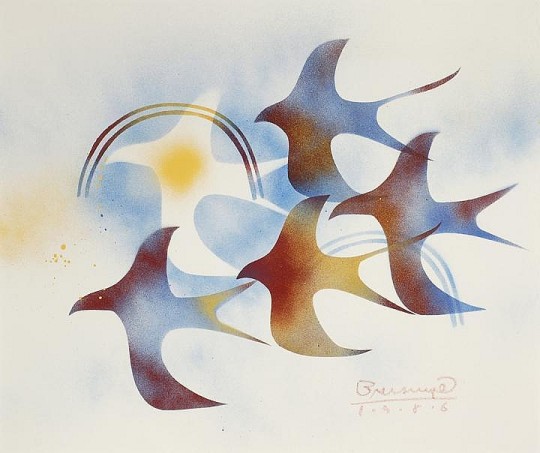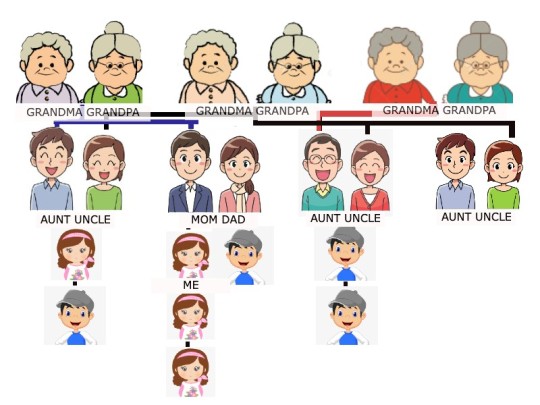Don't wanna be here? Send us removal request.
Text

I believe that this beautiful piece reflects the unity between the women in The Break. Although they lead separate lives and are sometimes distant from one another, they come together in a time of need. The image contains birds of the same family traveling together. Although they may be caught up in their personal lives, they preserve native culture by maintaining a sense of sisterhood and being there in each other's time of need and, coming back to their roots. Even when they are apart, they are attached.
Brascoupé Simon, Five Birds in Flight, 1986, Acrylic on canvas
0 notes
Text
Week 10 (Family Tree)

The person I'd like to discuss is my uncle (first picture). He is very important to my entire family’s migration story. He lived in Canada, but he went back home to India, married my mom’s sister, and brought her to Canada. My mom then married my dad (my uncle’s brother), who was still living in India. My uncle sponsored my parents and helped them become established In Canada. My mom and her Aunt then brought their parents, brothers, and sisters. I have always held a special place in my heart for my Uncle, as he is the reason that I am able to live in a country with so much opportunity. If it weren’t for him, I would not have such an opportunity-filled life or my current home. My uncle influences my relationship with indigenous people in Canada, as I am living on indigenous land thanks to the help he provided my parents with. We all have someone we owe credit to when it comes to where we reside. My relationship with my uncle taught me the importance of giving credit to those who helped you get where you are, and let you be where you are. This helps me understand, and appreciate the relationship every Canadian should have with the indigenous community (a relationship of gratitude).
0 notes
Text
Metis History- (Week 9)
Prior to reading this passage, I thought meties individuals were a mix-breed of Indigenous and European peoples, that originated from relationships made during the fur trade. This was the extent of my general knowledge. I was not aware that the term Metis was this complex, and the fact that the government has denoted specific areas to be “Metis land”. I also learned that the government has historically used the complexity associated with the Metis name as a way to justify not dealing with Metis issues. The government has since given them Indian status. Overall, I was unaware of how complex the Metis name was, and how the definition of a Metis individual is much more than a person of mixed European and Indigenous descent. I believe that my misconception stemmed from a simple lack of knowledge and understanding, which further explains why it is so important for people to learn about Indigenous histories.
0 notes
Text
Indigenous Queer Studies -Week 8
Billy-Ray Belcourt does a great job at adding gendered and queer critiques to indigenous poetry and drawing connections between the two notions. It is pointed out that queer studies and indigenous studies have a common ground under the notion that both studies explore the idea of living, being, surviving, thriving, resisting, and resurging. Struggles associated with Indigenous feminism are described based on queer studies. The struggles of being an indigenous woman that lives contrary to the “grounded normativity” that describes the traditional way to be based on indigenous practices and knowledge. This article describes a branch of indigenous feminist struggles based on queer relationality and the effects of colonialism on both fields. The connections Belcourt draws between these concepts help me better understand the effects that colonialism has had on each. It allows me to understand from a different frame of view, as it describes how trauma associated with past treatment shapes a person’s mind in the present and affects their life.
1 note
·
View note
Text
We Still Stand Up- Week 7
Tasha Hubbard’s film was extremely heart-touching. She did a wonderful job at depicting the hardships First Nation individuals go through. The film starts off with the story of Big Bear, and how starvation was used as a tactic to get rid of the first nations. The film talks about the sacrifice Big Bear made for his family so that they wouldn’t starve to death. The film then showcases parents educating their children about the story of Big Bear, as well as the other injustices they endured. The main aspect of the film was the case of the killing of Colten Boushie. Colten was shot dead by a farmer for being in his own car, on the account that he was trespassing and trying to “steal”. The film goes through the trial, and the family interviews. This aspect of the film was especially heart-breaking. Hearing the sorrow of Colten’s family and the cries of his sister really hit my heart. I was astonished at how much compassion they still had, despite going through such an injustice. Although it is hard to watch, it provides great insight into how indigenous individuals are treated by society and the justice system. From the disgusting racist reactions of some members of society to the ins and outs of the trial, the film lays everything out. Overall, the film is a great way to educate the youth about First Nation history, and the obstacles they face today. It is best described in the Star Blanket and Hunt reading, when it is mentioned that “The stories we tell today will inform those of tomorrow”. Educating and advocating for the youth is the way to make the future brighter.
0 notes
Text
Mind Spread Out On the Ground & the Indian Condition- Week 6
Alica did a phenomenal job at laying out the generational trauma that occurs as a result of how indigenous individuals were treated. The most phenomenal part is her choice of title, as it really describes the essence of what she is saying. In the story, she unravels the layers of the trauma she has gone through. She even digs deeper and discusses colonialism, and describes the root of her trauma. She essentially describes what goes on in her mind, and lays it all out. She spreads her mind out on the ground.
I also believe that Mailhot describes the Indian condition as the cycle of despair caused by generational trauma. She describes that it is considered natural to think of life as a cycle of misery. She describes how indigenous people overcome a lot of obstacles, but they don’t look at it as resilience, just mere survival. This causes a constant cycle of misery, which is the Indian condition. Malhiot also describes how someone once said “it’s no wonder that this narrator is crazy. She’s Indian, and she’s smart. Who could survive that?’”. This speaks volumes about the Indian condition. The trauma they have endured causes them to live in this constant cycle of mental despair, and navigating the world in those conditions is not easy. Essentially, Indians are conditioned by the past to live in a sense of despair.
0 notes
Text
Beth Brant’s “A Long Story”-Week 4
Beth Brant’s story illustrates how the prominent positions Indigenous women once possessed within their communities were interrupted as a result of Canadian policies. In the story, the author compares the time at which Indigenous women’s children were taken to residential schools, to a modern-day lesbian women losing a custody battle. The story Beth told about the Indigenous women really showed how the residential schools took away from the prominence women had in Indigenous societies. Due to the psychological distress caused by losing their children to residential schools, the women lost their way of life in grief for their children. Due to this, society deemed them crazy. They were no longer looked at as prominent members of the community, they were just seen as crazy. I also feel that the title “a long story” alludes to the generational trauma that is still prevalent in current societies of women and men. The effects are still prevalent, making it “a long story”. In terms of current national politics, I feel as though we have come a long way in trying to ensure that different groups aren't subject to such occurrences, but there have been times in our recent history where gay couples were not allowed to get married/ adopt. However, the world is slowly making progress to create an environment where no groups traditionally considered as “other” is subject to such treatment at the hands of the law.
0 notes
Text
Super Indians- Song (Week 3)
The song “Four Five Seconds” by Rihanna, Kanye West, and Paul McCartney provides a great analogy for the story “Super Indians”. The story is narrated by a boy named Dene Cho, who works for the chief of a town that he feels has been colonized due to the chief’s lack of attention to his duties. Towards the end of the story, he decides to take the chief down and restore the glory of his town. This is reflected in the song Four Five Seconds, as the song describes a person who is ready to let their true feelings lose. Lyrics like “ Cause all of my kindness, is taken for weakness; Now I'm Four Five Seconds from wildin'” reflect Dene’s state at the end of the story, as he is done putting up with the chiefs ways, and decides to take action against him. The overall mood of the song also reflects Dene’s story, as the story ends at a climactic/turning point as Dene makes a decision, and the beat is very fitting for a moment of that sort.
0 notes
Text
Selfless- Etymology (Week 2)
A word that holds a great deal of significance to me is the word “selfless”. Upon further research, the etymology of the word selfless describes its origins to be from the poetry of Samuel Taylor Coleridge. Samuel used the word in his poem to describe the act of devoting oneself to something with no personal interest involved. The root of the word coming from a romantic poet like Samuel Taylor Coleridge resonates with my initial relationship with the word, as I've always believed that being selfless was the ultimate form of any kind of love. I was quite surprised that the word originates from a poet, as I had originally expected it to have originated from a word from another language like Sanskrit. Language and knowledge are very closely related as both depend on each other. Knowledge is necessary when you are trying to convey a language, and language is necessary when you are trying to convey knowledge. Something that I have found interesting about this exercise is the fact that I have never taken the time to consider where the words I use come from. Acquiring such knowledge is important, as it shows you how interdependent and vital different cultures are in shaping the world we live in today. This exercise helped further emphasize the importance of indigenous language revitalization, as it helped me realize that being aware of the root of a culture, helps you understand and appreciate its origins and importance.
1 note
·
View note